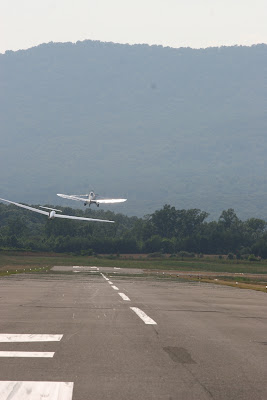I had my longest flight to date in the 1-36 on Saturday: two hours and 12 minutes. That's certainly nothing to brag about, but I'll take it. All I could find was strong sink after releasing from tow and I made it back to the 45-degree traffic pattern entry point at about 1,500 feet AGL. I was just about to start my Before Landing checklist and had the fish story ready to explain my embarrassingly quick return to the airport when I stumbled into a booming thermal that carried me up to 5,000 feet MSL. The lift got stronger and stronger; I could have stayed aloft the rest of the day. But I forgot my water bottle. After two hours in the hot sun, I was dehydrated and convinced that I should get this giant winged beer can back onto the ground so that I could get a cool drink. I made the initial radio call and the duty officer replied, telling me to stay up for a few more minutes so that I could claim the coveted "flight of the day." Unfortunately, I couldn't understand him.
On Sunday, I got checked out to fly from the back seat in the K-21 so that my future passengers will be treated to a better view riding in front. In tandem gliders, the pilot usually sits in the front seat. The sight picture was a little different, and I was constantly looking to either side of the head blocking my view forward. Flying the tow seemed strange from the back. Someone later told me to keep the towplane's wings sprouting from the passenger's ears, which seems like a reasonable gouge. The wing also blocks the view of the runway leading up to the base turn in the pattern--that required a slight bit of anticipation. I'll practice a few more times with club members in the front before I take an uninitiated passenger up.
Sunday was a weird day. The humidity was low, and Front Royal Airport was in a big blue hole. A weird cloud formation appeared to the south that looked like lennies, but that made no sense with such light winds aloft. During my back seat checkout earlier in the morning, the tows were pretty sporty, but it turned out to be sporadic bubbles of lift that we were hitting rather than well-defined thermals. It was difficult to work. A few people had extremely short flights after encountering large patches of 8-10 knot sink near the ridge. Around noon, there were no cumulus clouds in sight except for a few way off to the east. One pilot went up to sniff out the conditions, expecting to make a brief flight. He called at 5,000 feet, and shortly thereafter, all the private ships launched.
When my spot in the tow queue came up, I happily jumped in the Sprite, hoping to get the second two-hour flight required for my Bronze badge. Among other things, I need to earn the Bronze badge in order to be permitted to take any of the club ships out of gliding distance from the airport. The tow was rough: the updrafts and associated sink were so strong that I had a difficult time keeping in position behind the Pawnee. I had to make very large control inputs to level the wings after a few of the shocks.
At about 2,700 feet AGL, the line went slack. The Sprite was knocked so far out of position that I decided to release. I tried to backtrack to the lift that we hit on tow but found nothing but vario-pegging sink. I beat back to the airport and, for a moment, it looked like I might need to make a straight-in approach to runway 10 rather than flying a pattern for runway 28. I didn't open the dive brakes until turning base, where I hit what felt like strong lift. Brakes full open and an aggressive slip were necessary to get the glider down onto the grass.
I elected to put the glider back in the hangar rather than trying again. The strong lift and unusually high cloud bases allowed one pilot to climb to over 10,000 feet MSL and several others made it over 9,500 MSL. Even after 5pm, the lift was going strong. One club member landed only because he didn't want to make the official observer for his badge claim hang around too long after a nearly 4-hour flight. Another said that his averager had reported 9.5 knots up. Yet another pilot reported that the updrafts were so strong that he experienced regular shocks of several G in the Grob 103, the heaviest of the club sailplanes, and that descending required full spoilers at high airspeeds. A booming day, for sure.
No doubt the light 1-36 would have been tossed around in those turbulent thermals. And the Sprite has a pretty narrow speed range--min sink at 42 mph and maneuvering speed at 64 mph--so I'd certainly need to fly well into the yellow arc to get back down. While I'm bummed that I missed out on what a few people said was the best thermal soaring day at this location in the past two years, I think the conditions may have pushed my comfort level right now. So it goes.


No comments:
Post a Comment